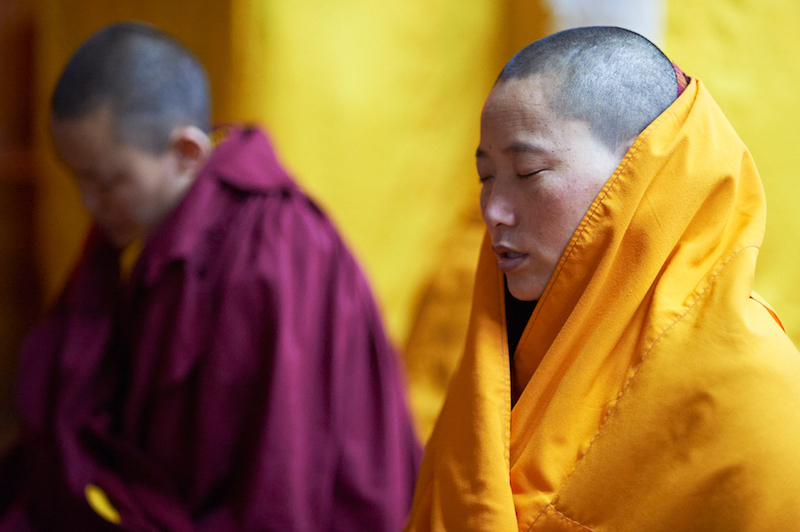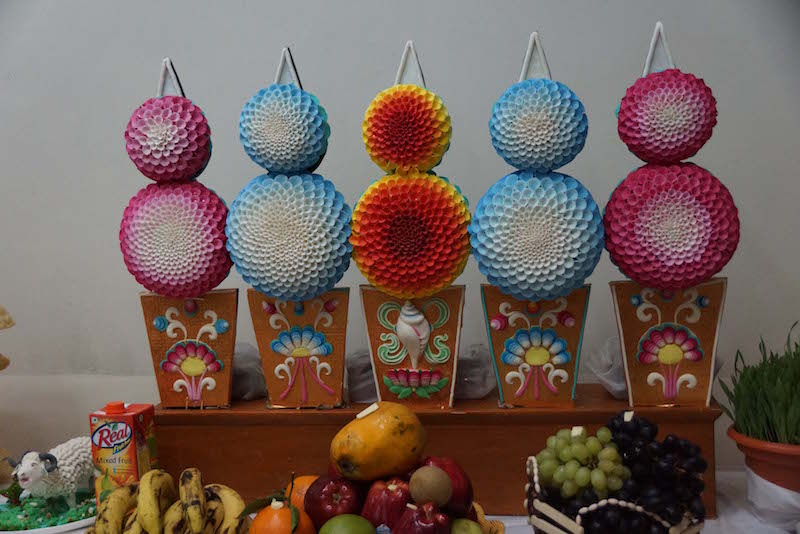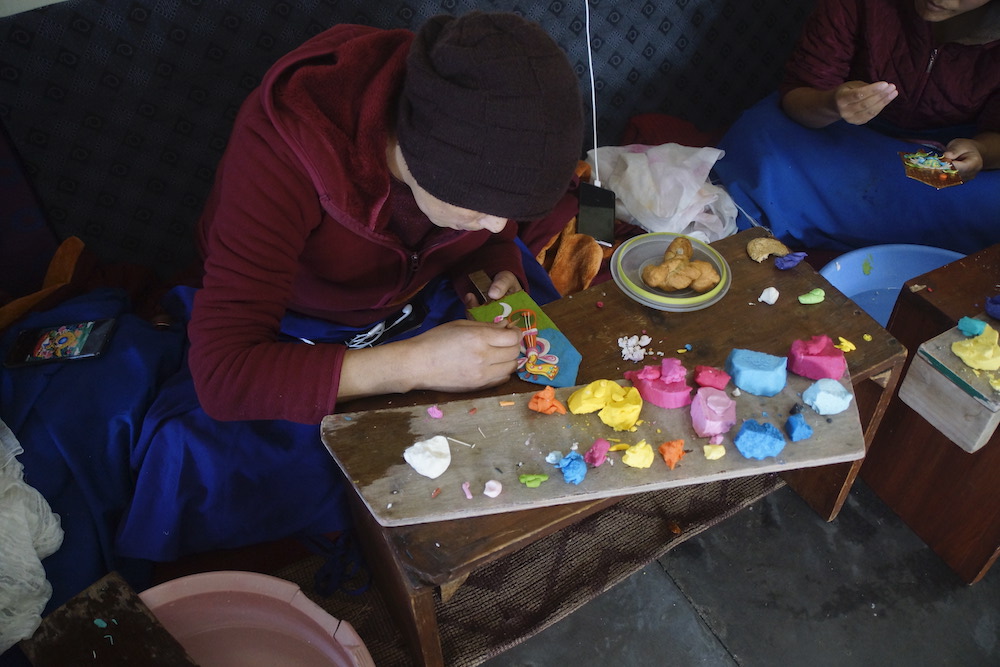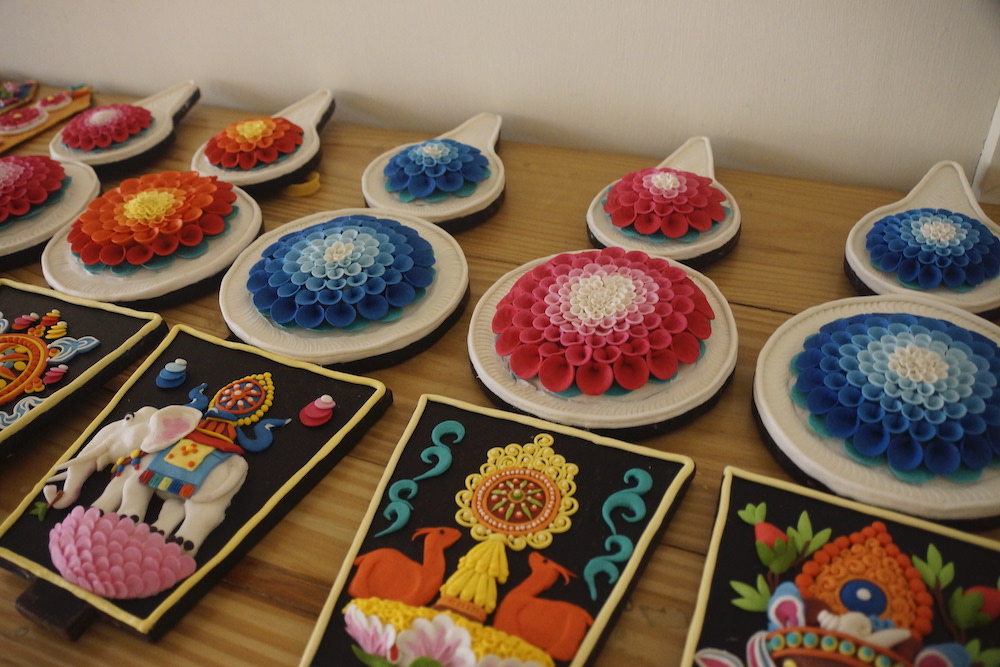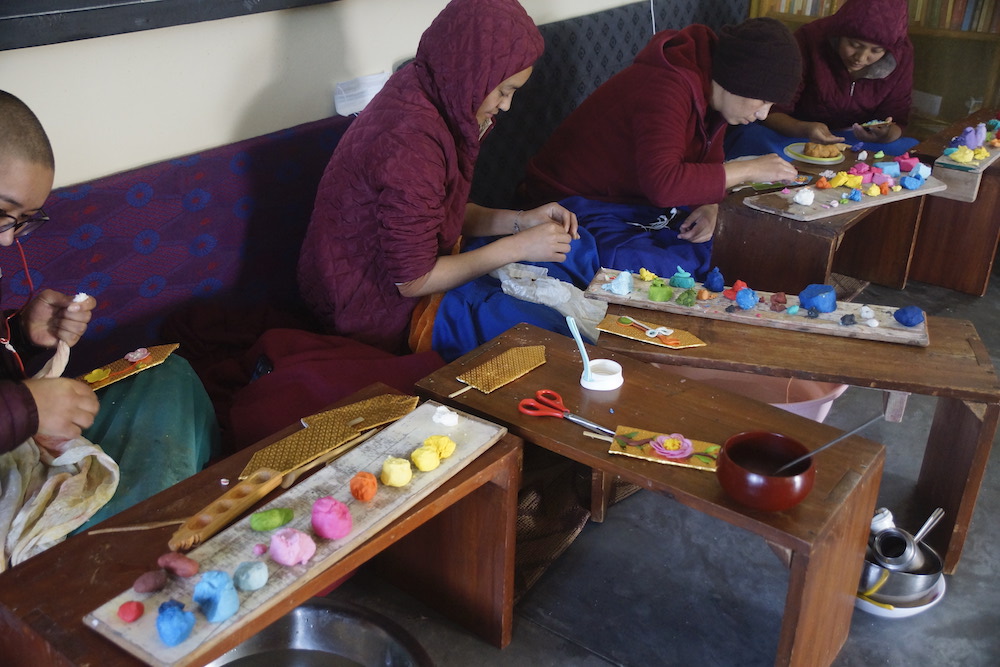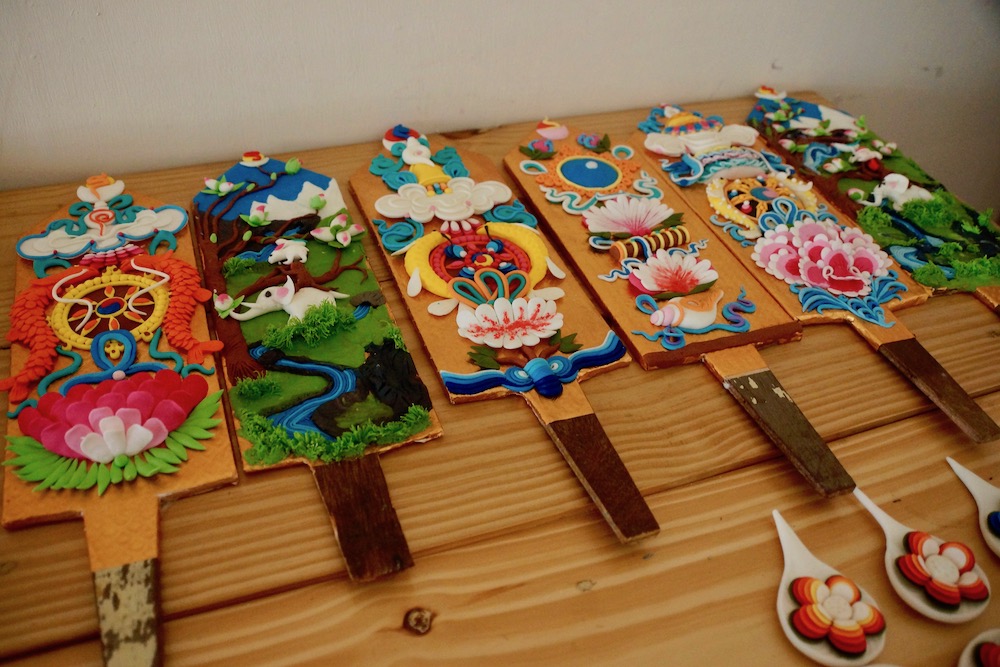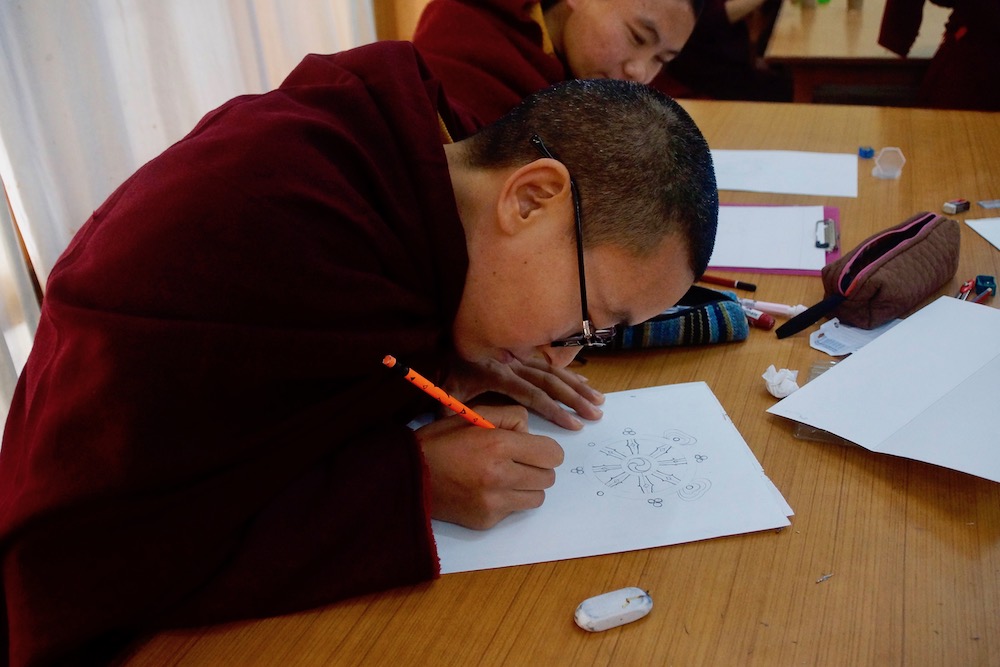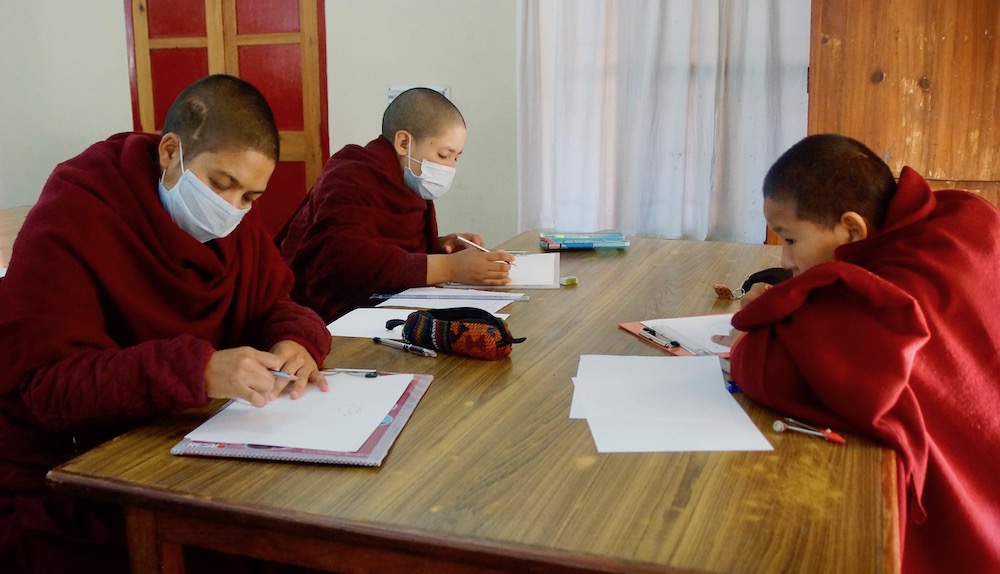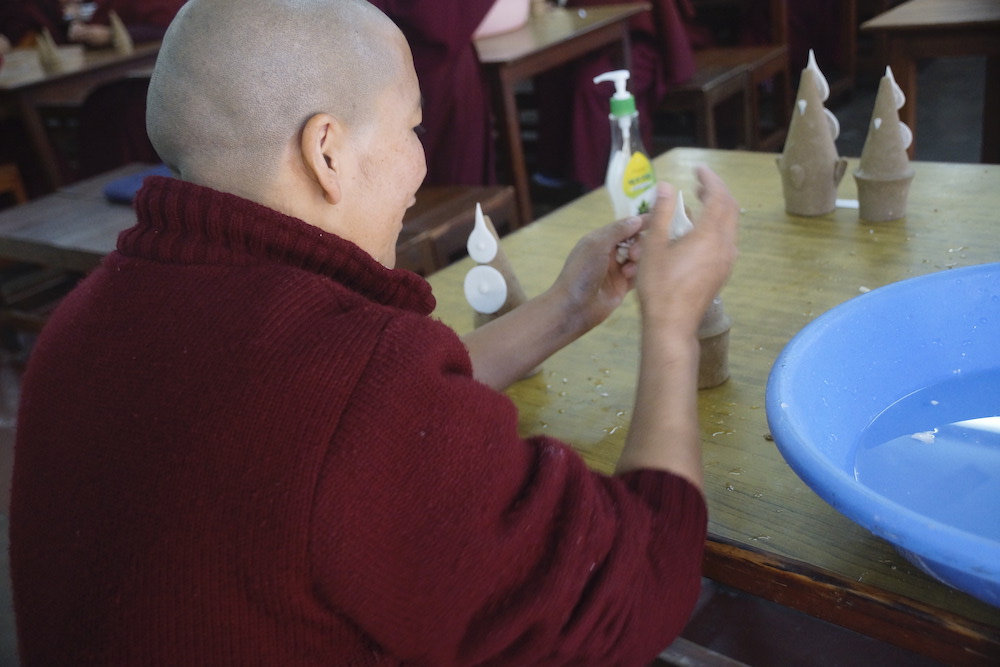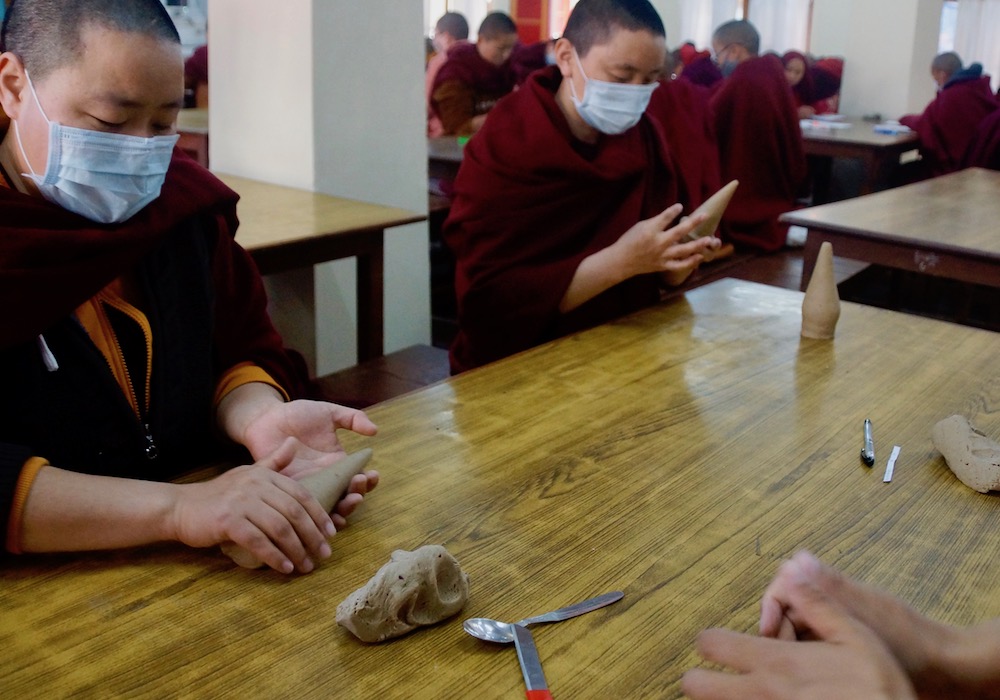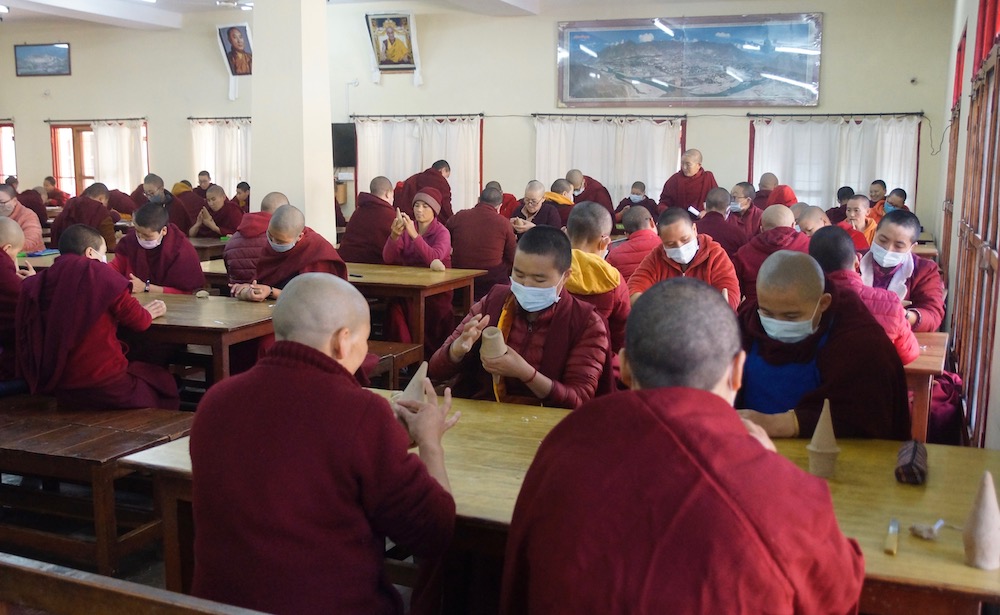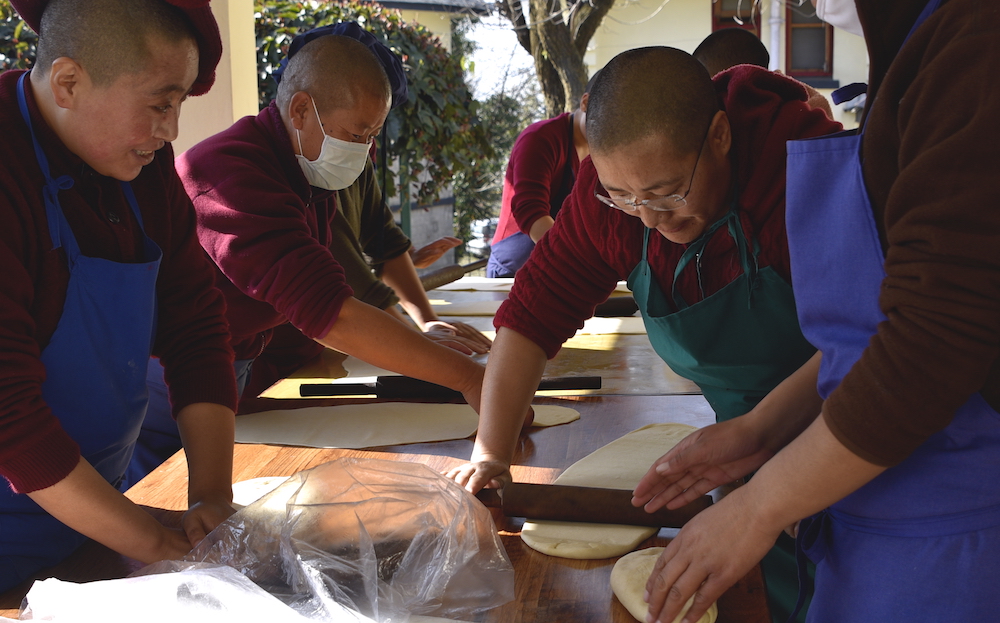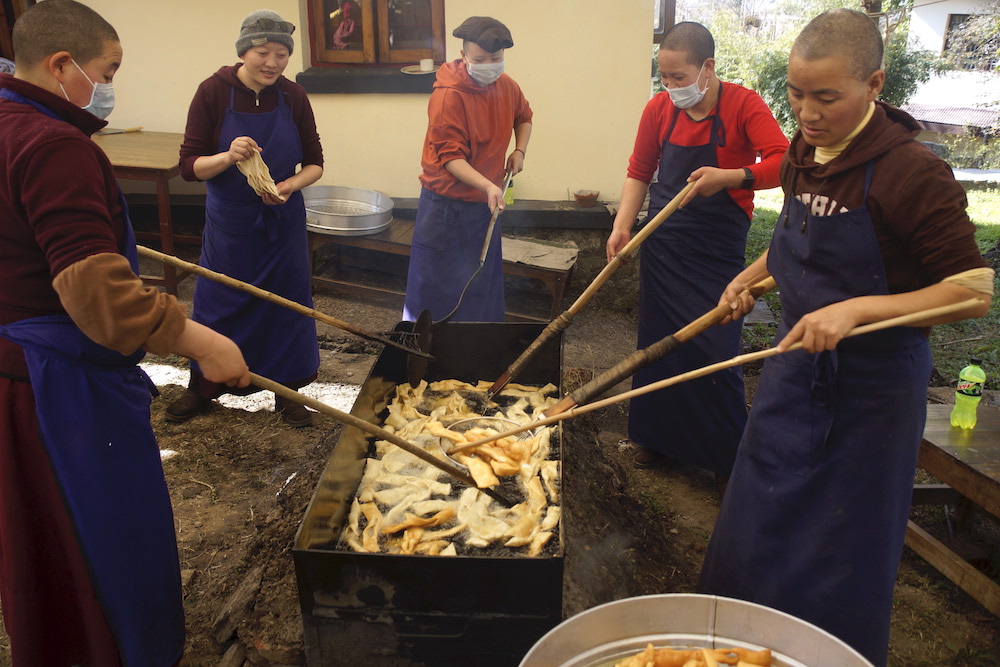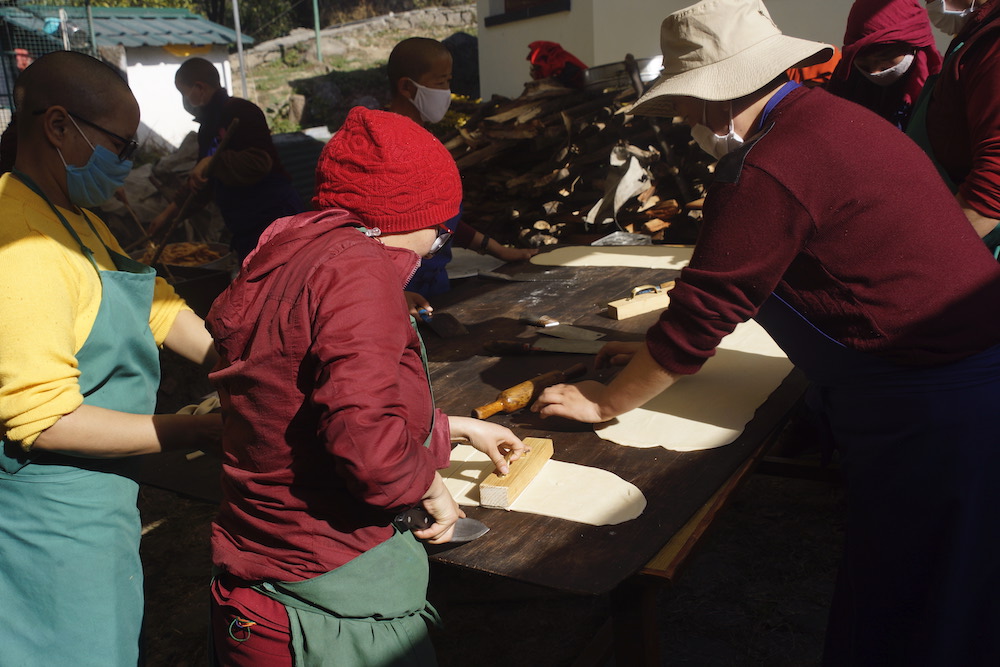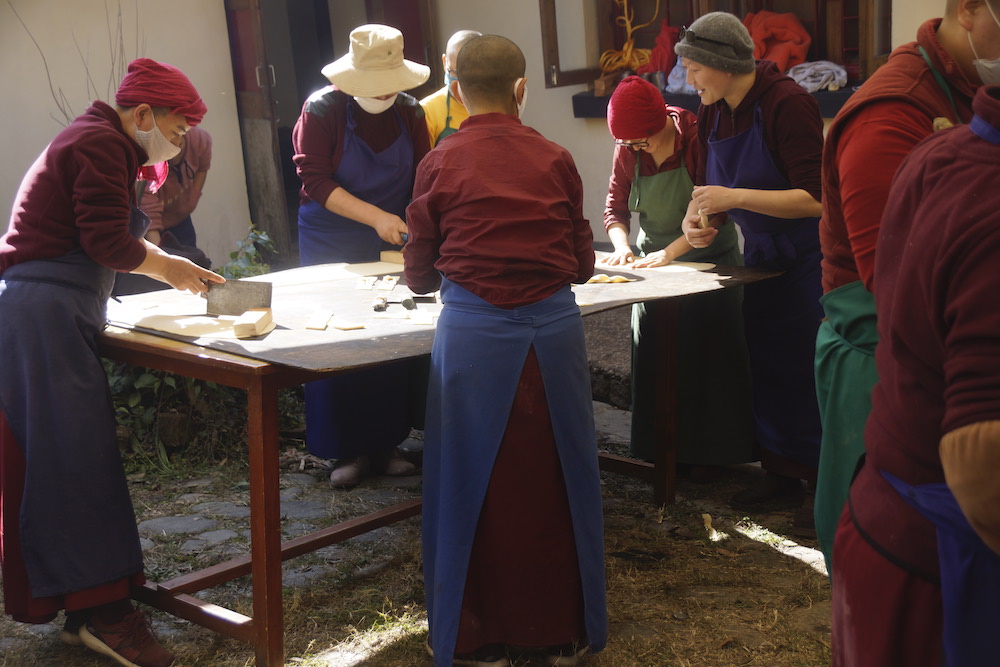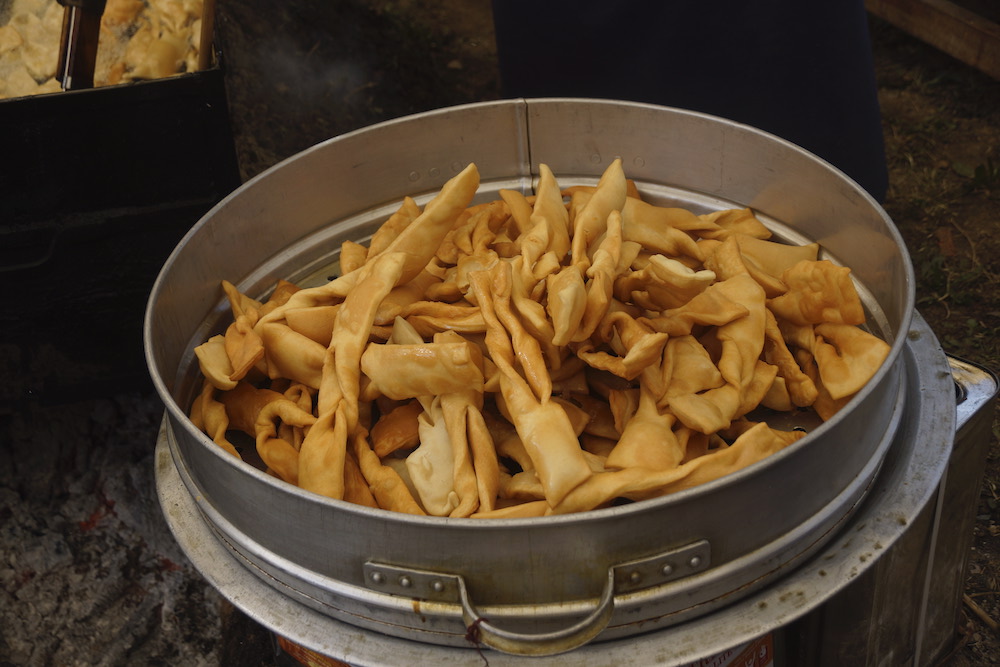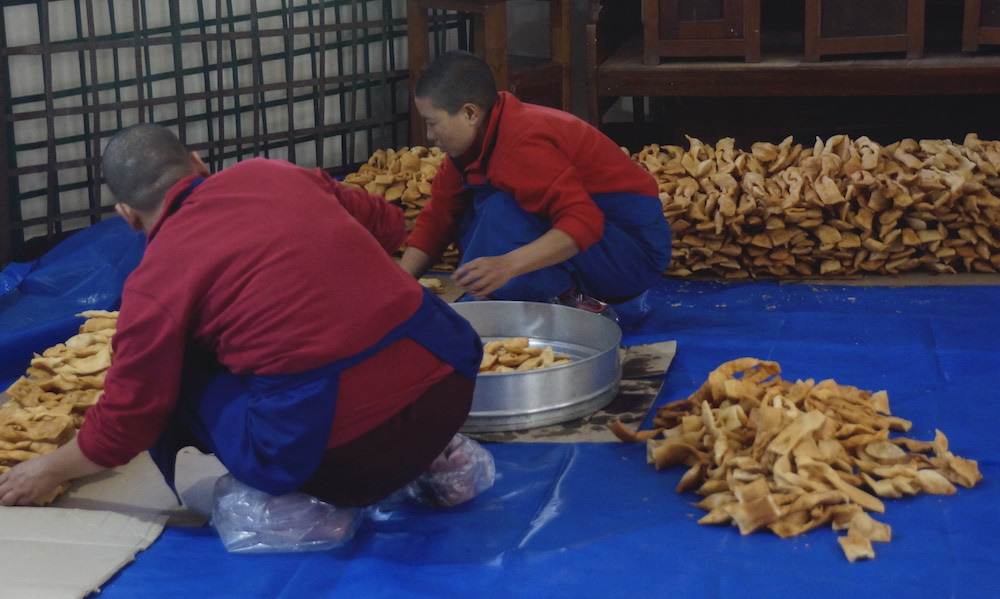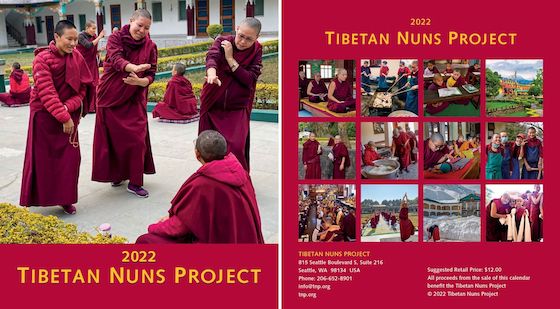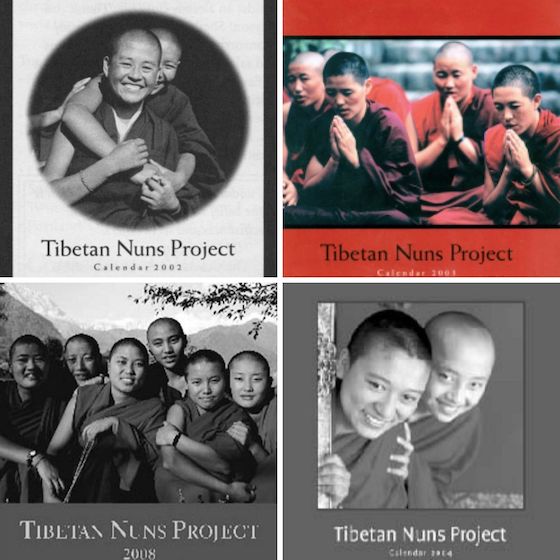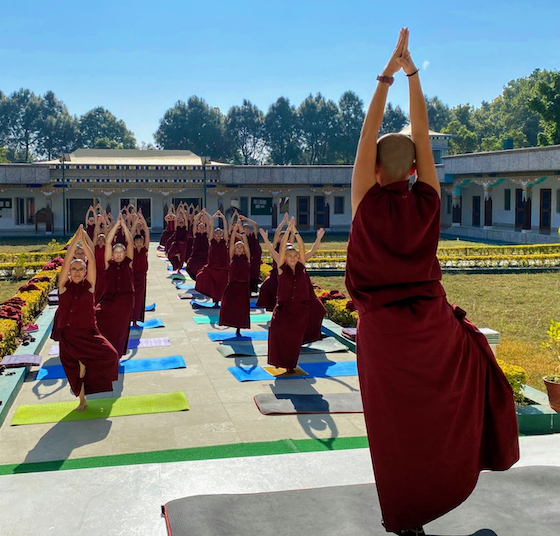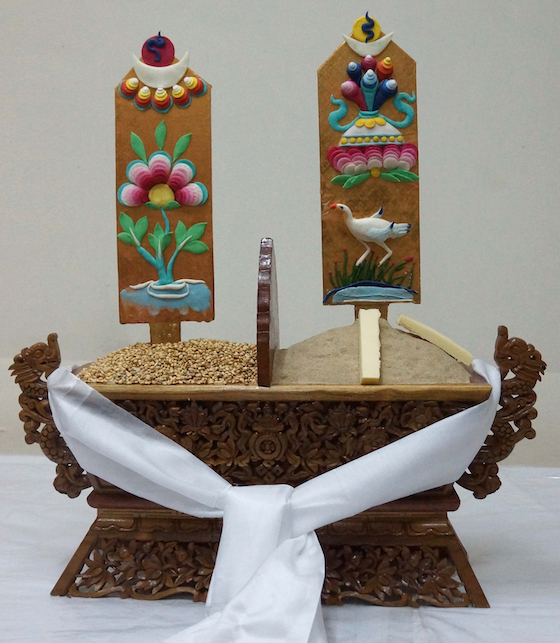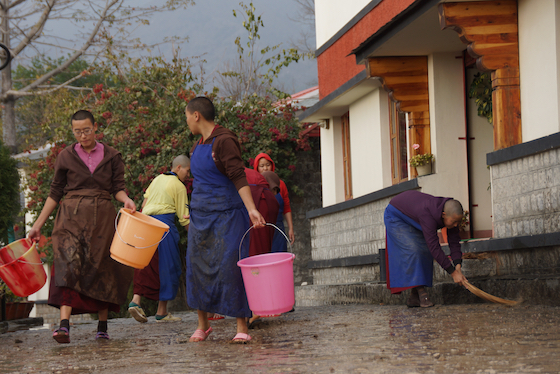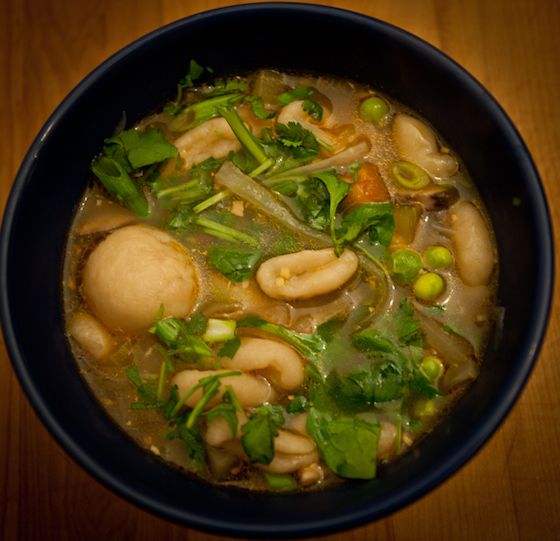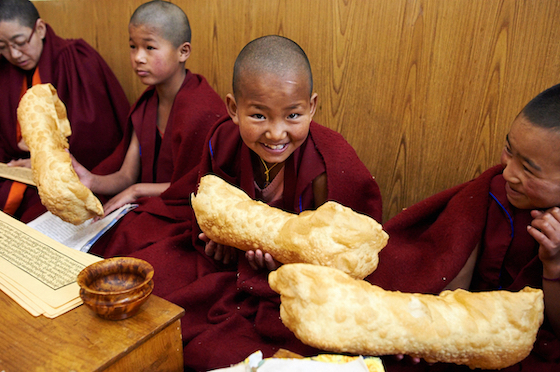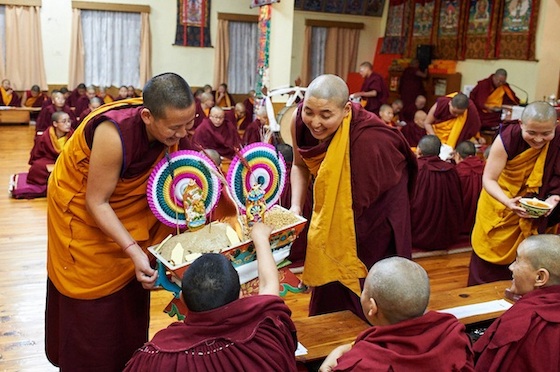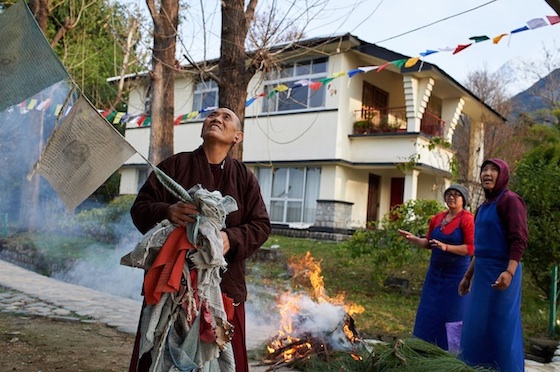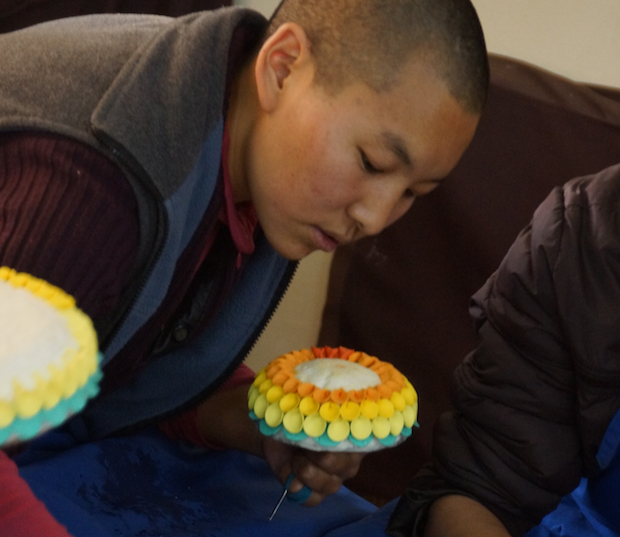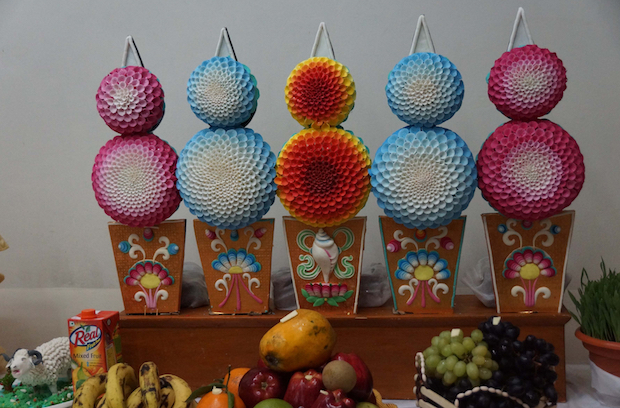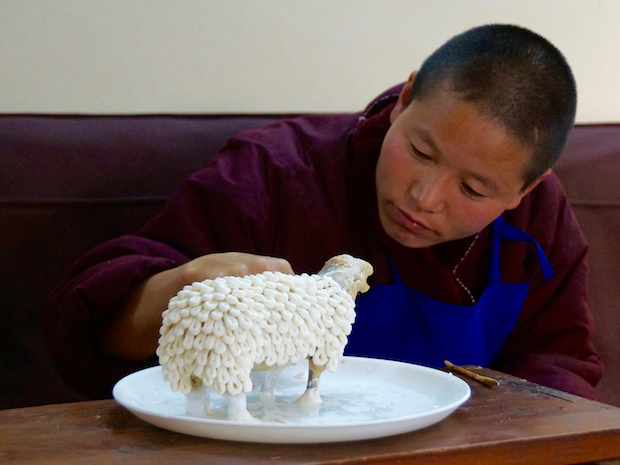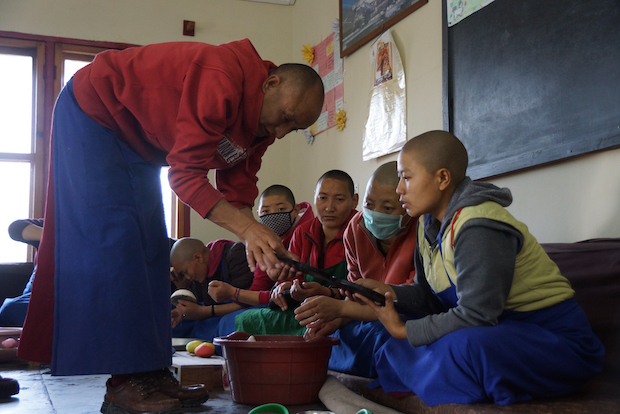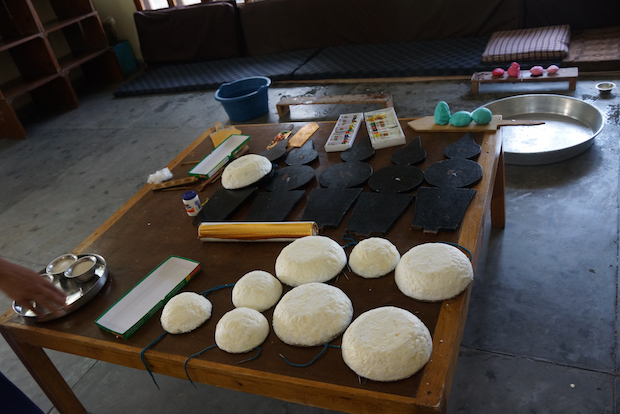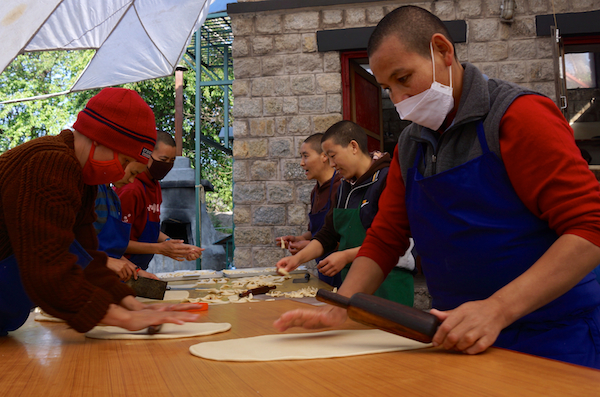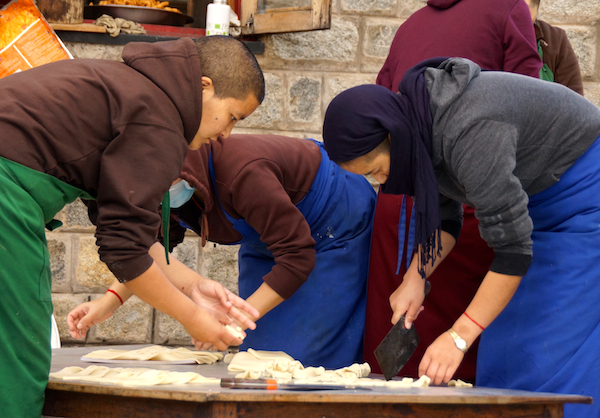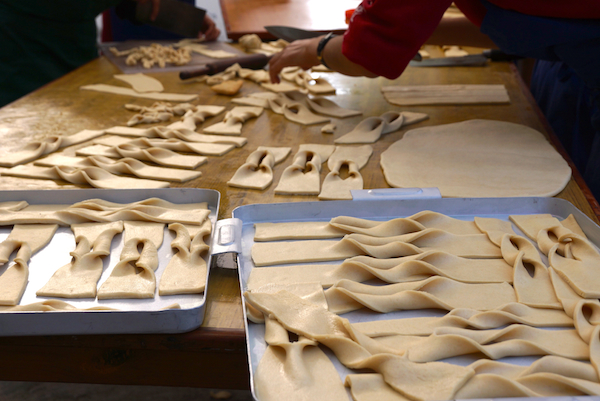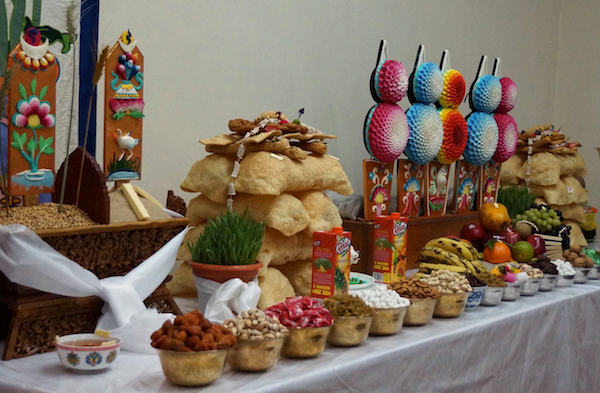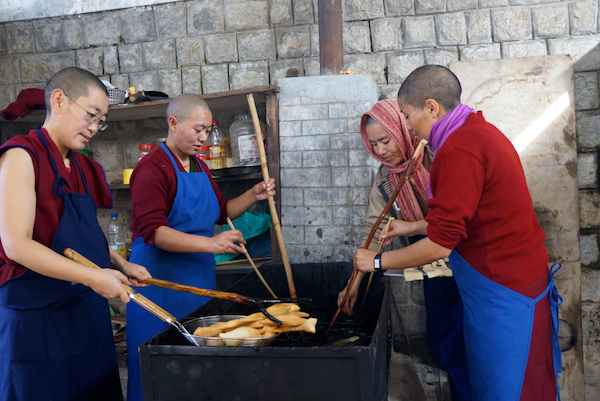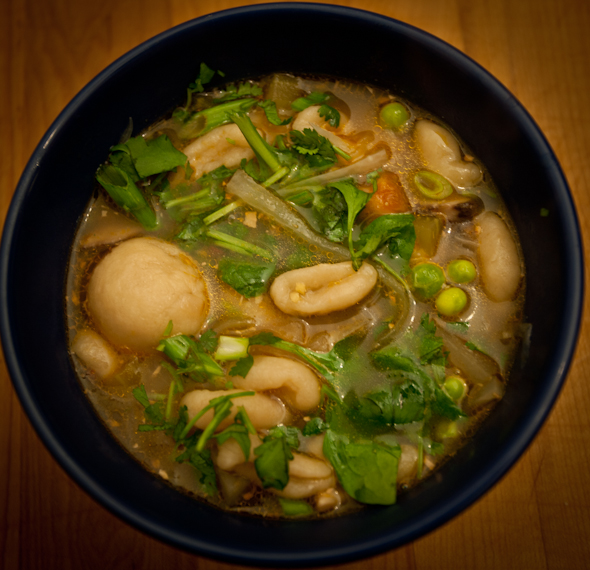Sit back, relax, and take an armchair journey to Dolma Ling Nunnery and Institute in India, home to about 250 Tibetan Buddhist nuns. The wonderful team of Media Nuns at Dolma Ling took dozens of photos showing the nuns preparing for and celebrating Losar, Tibetan New Year.
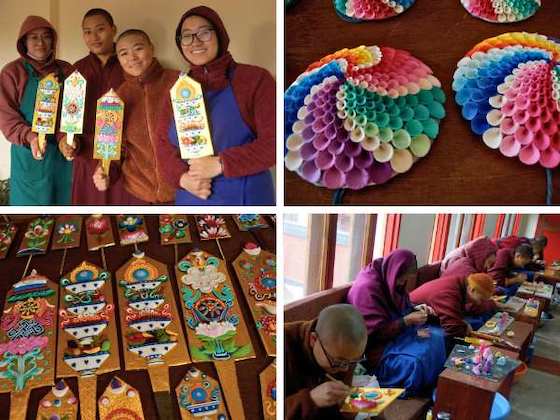
The art of making sculptures out of butter has been practiced for over 400 years in Tibet. This highly revered artistic tradition is now being taught to nuns at Dolma Ling and is being preserved by them.
Losar or Tibetan New Year is a very special time of year. This year, Losar fell on February 10th and, according to the Tibetan calendar, is the start of the year of the Wood Dragon 2151. In the traditional calendar, each year has an animal, an element, and a number.
Losar-related rituals fall into two distinct parts. First, the nuns, like all Tibetans, prepare for the new year and say goodbye to the old year, letting go of all its negative or bad aspects. Part of the preparations involves cleaning the nunnery.

In the weeks leading up to Losar, the nuns make elaborate butter sculptures of flowers and Buddhist sacred symbols to decorate the Losar offering table and offering boxes.
Since 2001, the Dolma Ling nuns have been studying the ancient art of butter sculpture making. In addition to the larger butter sculptures made for the Losar altar, the nuns make smaller displays on individual sticks, called tsepdro, for each person in the nunnery — nuns, staff, and teachers. This means that each Losar, the nuns make around 300 of these, using a wide variety of designs. The nuns display them in their rooms as part of their Losar altars and offerings, as a kind of bundle of auspiciousness.
Besides making butter sculptures, the nuns prepare special Losar foods like the deep-fried biscuits called khapse. Khapse means literally “mouth-eat” and the dough is usually made with flour, eggs, butter, and sugar. It is then rolled out into various shapes and sizes. The most common shape is the small twisted rectangular pieces served to guests.

Each year the nuns make khapse in various shapes and sizes. These deep-fried Tibetan cookies are a staple of Tibetan New Year celebrations everywhere.
On the night of the 29th day of the 12th month, or the eve of Losar, Tibetans eat a special soup called guthuk. Guthuk is eaten only once a year as part of a ritual of dispelling any negativities of the old year and to make way for an auspicious new one.
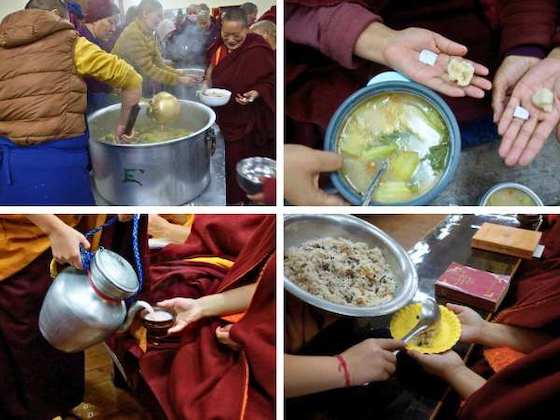
The top photos show nuns getting guthuk soup with the dough balls containing hidden messages. The bottom photos show the special tea and sweet rice served in the temple at Losar.
Guthuk has at least nine ingredients and the soup is extra special because each person receives a large dough ball containing a hidden item or symbol in it. Each item is meant as a playful commentary on the character of the person who gets it.
Before the first day of Losar, the nuns create an elaborate altar or offering table using their large butter sculpture flowers and stacks of specially made khapse. The Losar altars serve as prominent, central symbols of a wish to cultivate a generous heart and to invoke beautiful blessings for the New Year for all sentient beings.
The nuns also use their butter sculptures to decorate chemar bo. The chemar bo is an open, ornately carved wooden box divided down the middle. The left side is traditionally filled with roasted barley seeds and the right side is filled with chemar, made of roasted barley flour (tsampa), sugar, and butter. On arriving, Losar guests are invited to take a pinch of the chemar, after which they offer a blessing and good luck wish while throwing the chemar in the air with three waves of their hands and then taking a tiny nibble. The chemar is an auspicious offering to make at the Losar shrine to bring blessings in the new year.
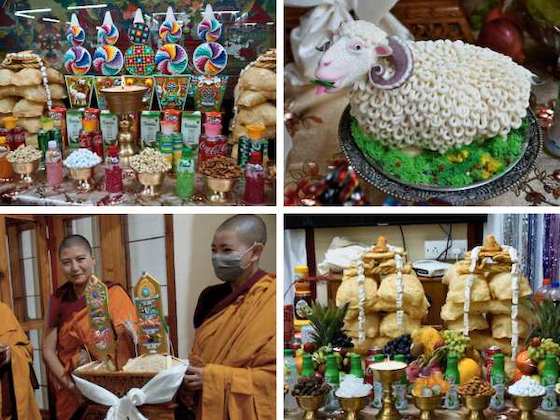
The Losar offering tables are decorated with butter sculptures and large pieces of khapse called bhungue amcho or donkey ears. These big hollow tubes of crispy pastry are stacked on the Losar altar and decorated with strings of dried Tibetan cheese.
On the day of Losar itself, Tibetans get up early in the morning and wish each other “Tashi Delek” or Happy New Year and then go to the prayer hall for prayers. Part of the prayer ceremony includes tsok, the offering of blessed food including khapse and fruit.
At the end of the puja or prayer ceremony, all the nuns line up to pay homage at the throne of His Holiness the Dalai Lama and to the nunnery’s leaders. They offer white kataks, ceremonial Tibetan prayer scarves.
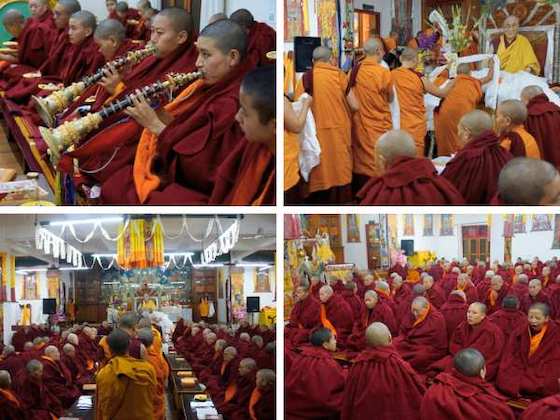
Nuns play a Tibetan wind instrument called gyaling somewhat like an oboe as part of their prayers. They also offer kataks to the portrait of His Holiness the Dalai Lama.
Visiting others is a special part of Losar. The nuns and staff at the nunnery visit each other’s rooms to wish each other a happy new year and to drink cups of traditional Tibetan salty butter tea.
It is customary to hang new sets of prayer flags at Losar. Old prayer flags from the previous year are taken down and burned with bunches of fragrant pine and juniper. The nuns also hang new prayer flags with a wish that all beings everywhere will benefit and find happiness.
If you would like to hang Tibetan prayer flags, you can order prayer flags that are made and blessed by the Dolma Ling nuns.

Tibetan prayer flags are used to promote peace, compassion, strength, and wisdom. Tibetans believe the prayers and mantras will be spread by the wind and bring goodwill and compassion to benefit all beings.
On the third day of the Tibetan New Year, a special incense-burning offering called sang-sol is held. While many nuns travel home to visit their families at Losar, some nuns remain at the nunnery and take part in this special event.
After the Losar holiday, the new academic year begins and, if space allows, new nuns join the Tibetan nunneries in India. If you would like to sponsor a nun for just $1 a day, we are always looking for more sponsors.
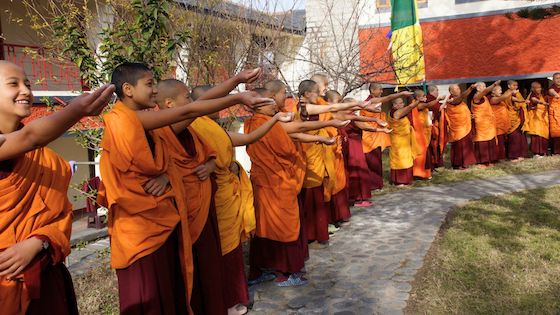
The nuns gather in a line or circle. Each nun takes some tsampa (roasted barley flour) in her right hand as an offering. They raise their arms simultaneously twice and then, on the third time, they throw the tsampa high into the air shouting “Losar Tashi Delek”.
Thank you for supporting the nuns! You are educating and empowering them and helping to preserve Tibet’s wisdom and culture. We wish you a very happy, healthy, and peaceful New Year.


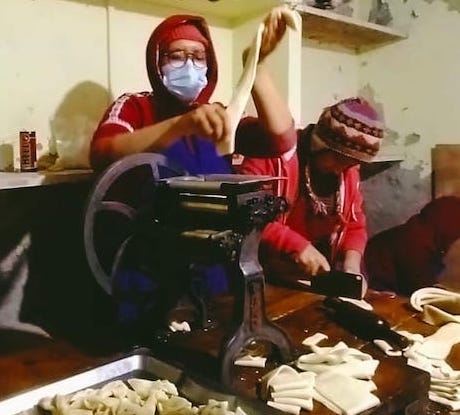
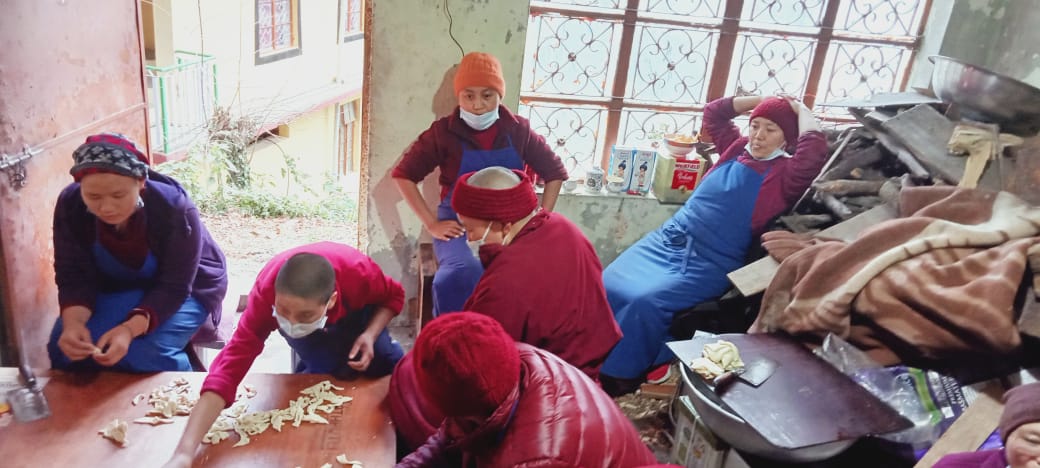
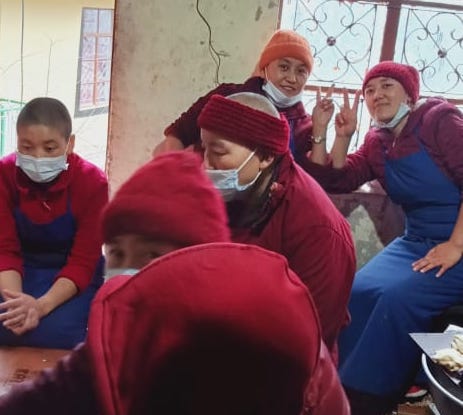
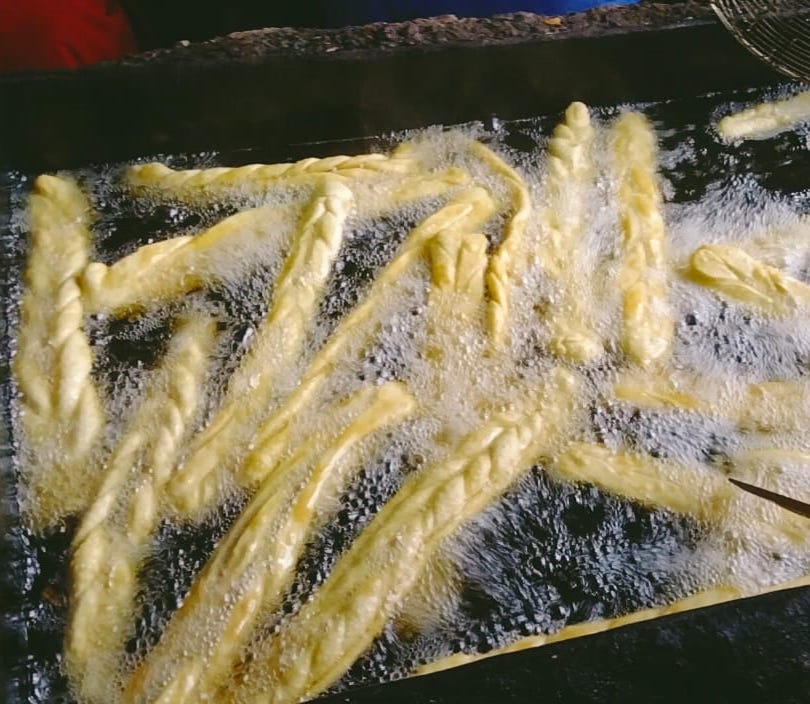
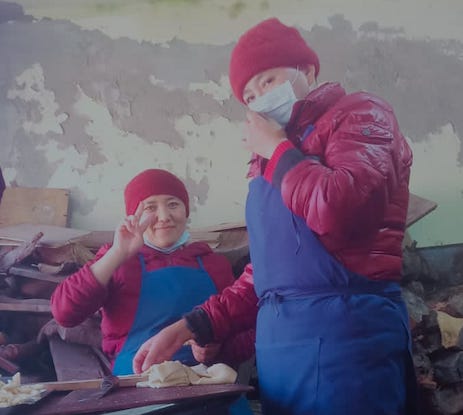
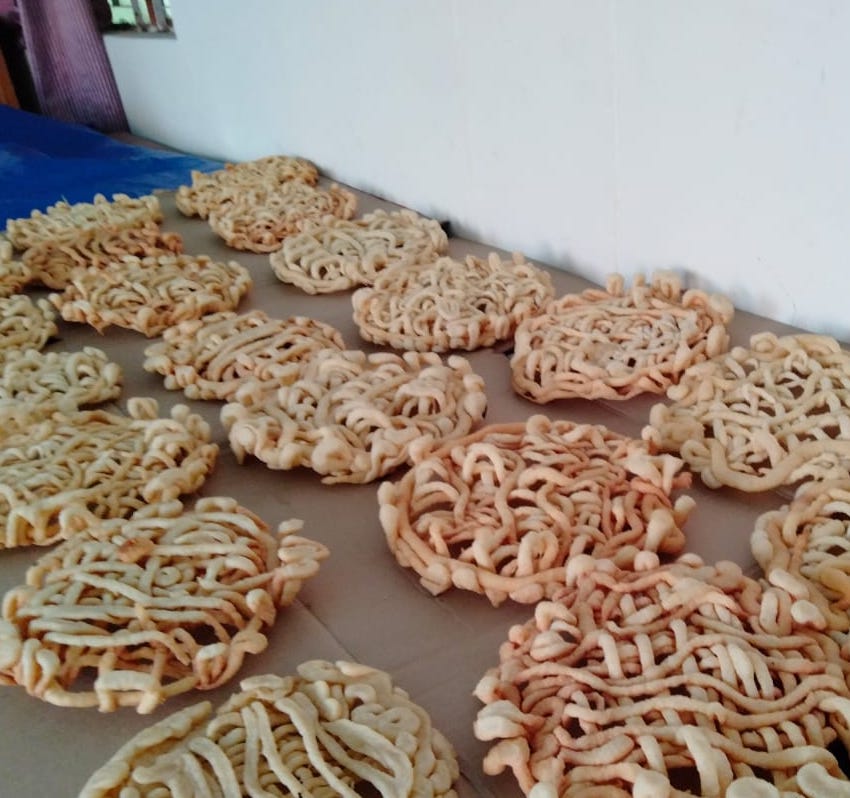
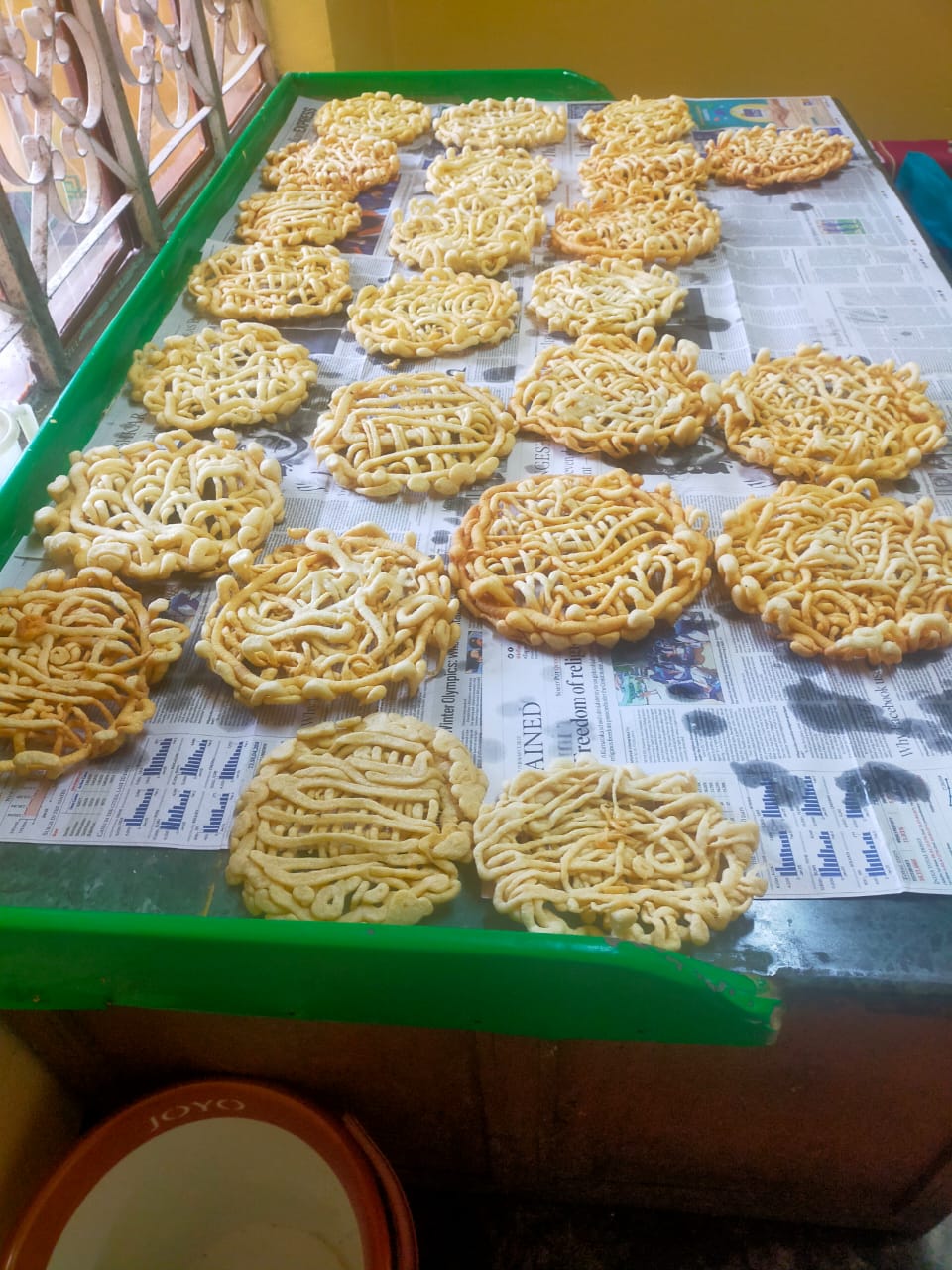
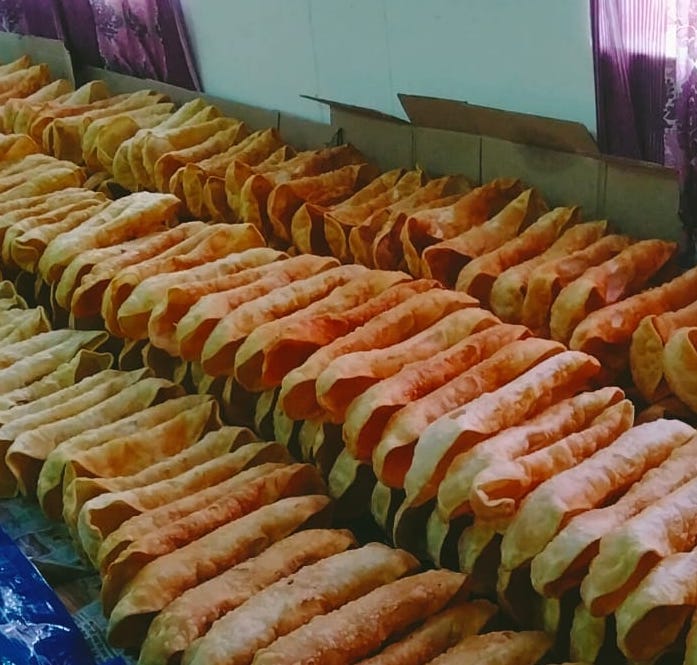
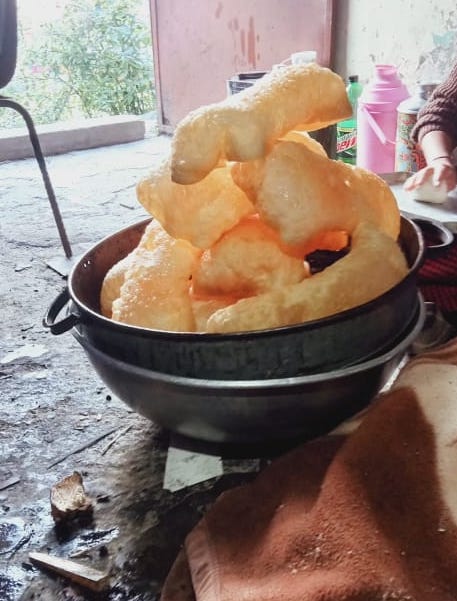
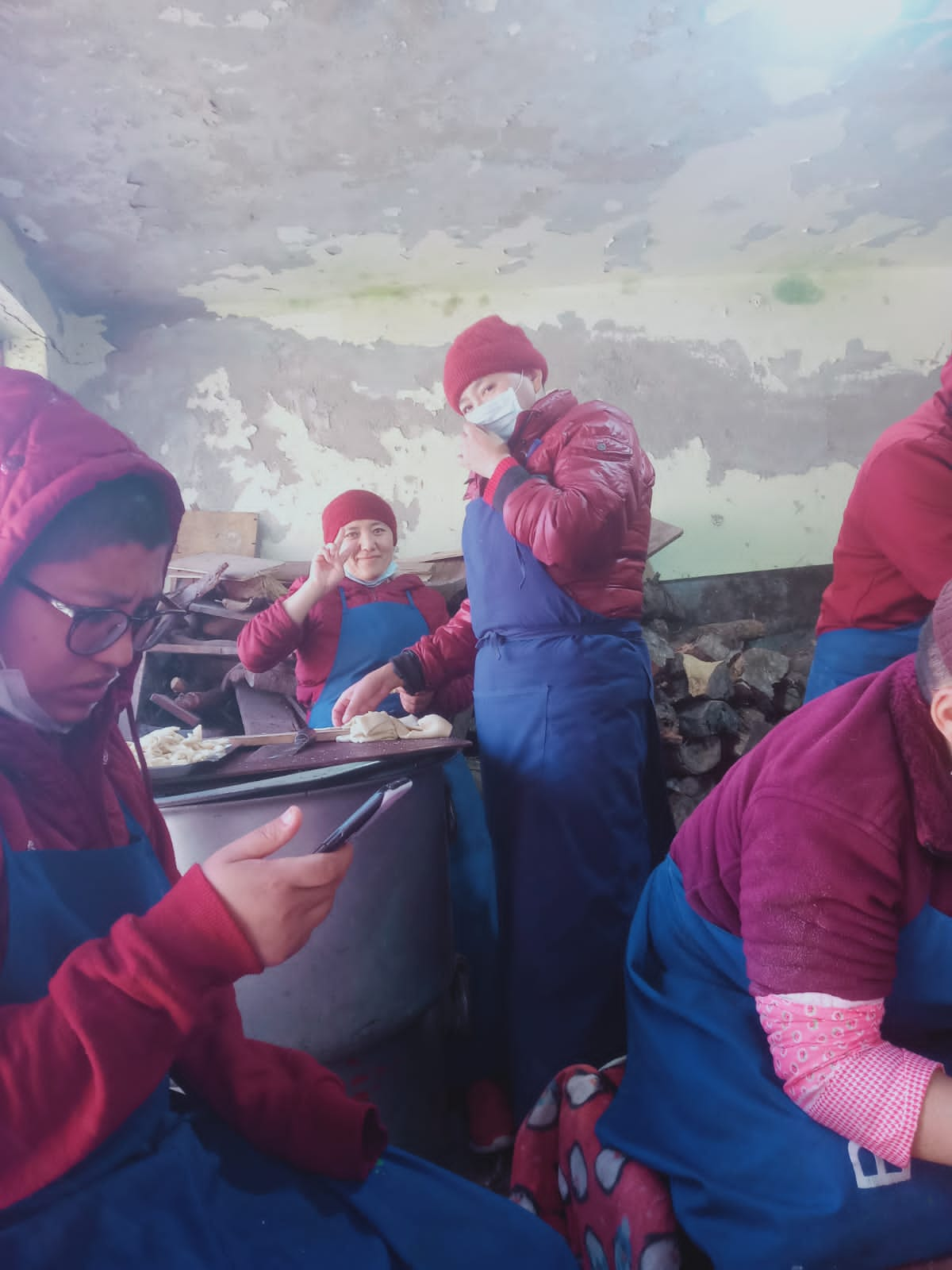




































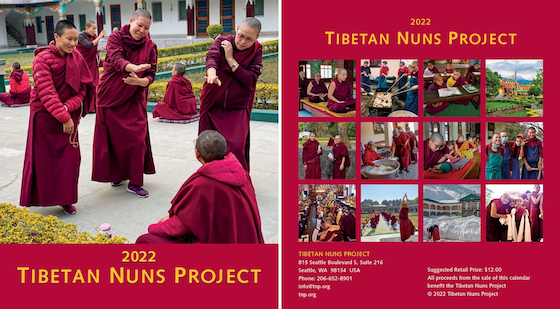
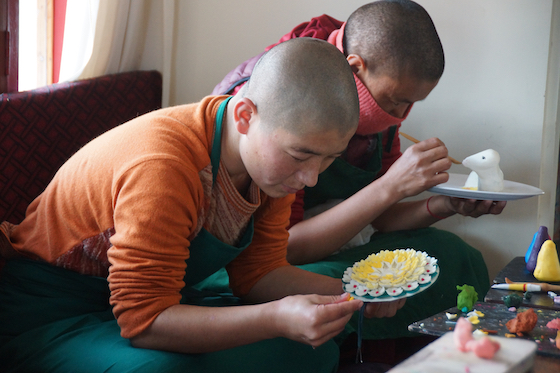
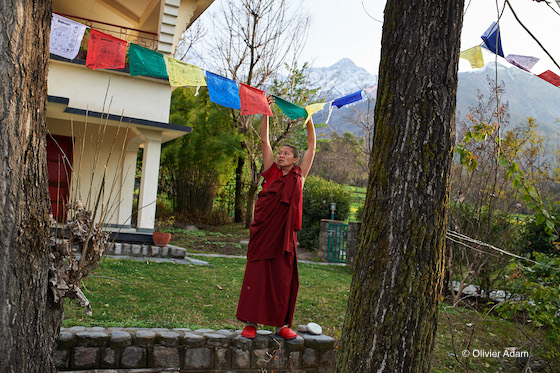
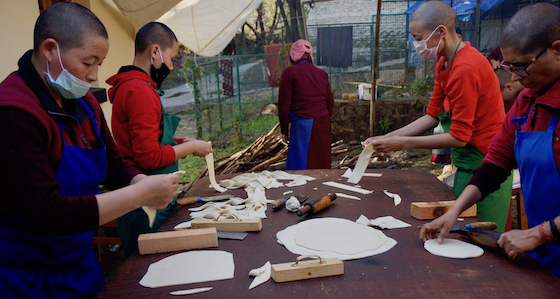

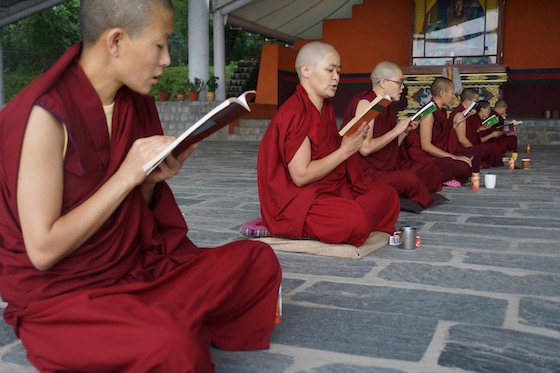
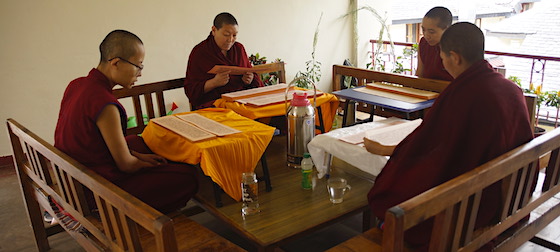
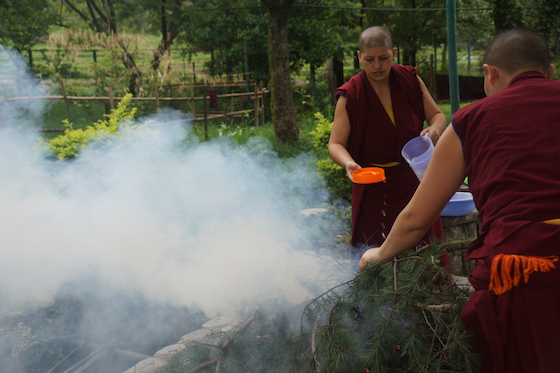
 Around the world, His Holiness the Dalai Lama’s birthday on July 6th will be celebrated with happiness and prayers for his good health and long life. This year, His Holiness the Dalai Lama turns 87. The nuns will pray and make special offerings of tsok, khataks (prayer scarves), and sangsol (incense offering) to His Holiness. It’s a day of celebration with special food, such as
Around the world, His Holiness the Dalai Lama’s birthday on July 6th will be celebrated with happiness and prayers for his good health and long life. This year, His Holiness the Dalai Lama turns 87. The nuns will pray and make special offerings of tsok, khataks (prayer scarves), and sangsol (incense offering) to His Holiness. It’s a day of celebration with special food, such as 